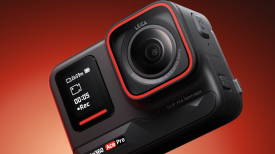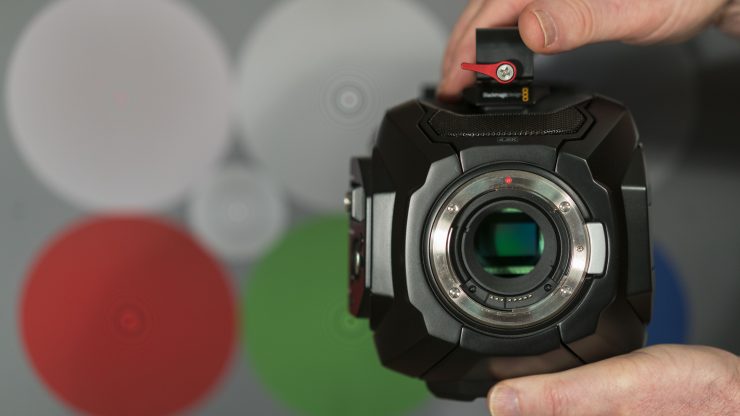
Blackmagic Design’s URSA Mini 4.6K was one of the most highly anticipated cameras of 2016. The combination of a Super35 sensor, 4.6K resolution, with built-in Apple ProRes and RAW recording to CFast 2.0 cards was a first at its price point. Initial footage posted online looked very convincing, but how does the camera actually perform on the test bench? Newsshooter has once again commissioned renowned camera tester Alan Roberts to evaluate it scientifically. The result is an EBU camera report that has examined the image quality in detail.
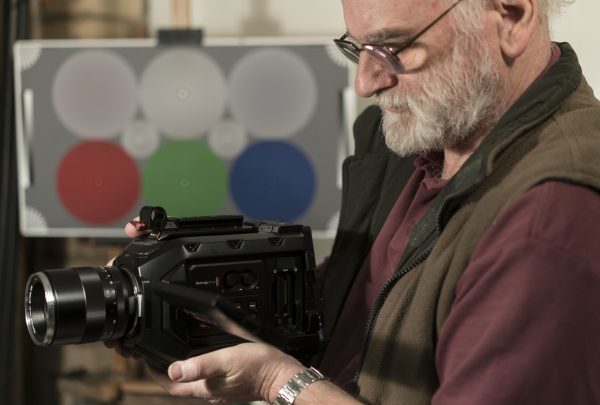
EBU camera tests focus on aspects of a camera’s image that will affect the final image after TV transmission. Aliasing, noise, dynamic range, rolling shutter, sensitivity and colour are all carefully examined. Although Alan’s test setup is relatively simple he uses his own specially created software to analyse the images. For the test a Zeiss ZE 100mm f2 macro lens was used.
These results are interesting to all users, but will be critical to those of us who work for broadcasters. If you work primarily for web, then it’s worth bearing in mind that your footage won’t necessarily need to meet the same criteria, as video platforms like Vimeo and YouTube compress differently to TV. Basically, if your web video looks good enough to you and your clients, then it is good enough. It is entirely possible that some aliasing in your image might actually be perceived as making a video look ‘better’ online. Still, even if you do work mainly for online, the report will provide a useful way to assess the qualities of the camera.
The EBU groups cameras into specific tiers for both UHD and HD.
For UHD Tier 1, a camera must have a minimum sensor pixel count of 3840 x 2160 in each of R & G & B. Every camera tested except the Sony F65 has thus far failed to reach this – mainly due to the limitations of using a Bayer-patterned sensor (It would be interesting to see how RED’s latest 8K sensor cameras would fare).
The next rung down is UHD Tier 2 and to qualify cameras must have a sensor pixel count greater than 2880 x 1620. A Tier 2 camera should process in at least 10-bit and can be 4:2:0, but 4:4:4 is preferred. Strictly speaking it must also have timecode genlock and internal recording at 200 Mbps or higher for 4K. Cameras that have met this include the ARRI Alexa, Amira and the Canon C300 mkII.
In HD there are four tiers with several subdivisions. A Tier 1 camera can be used for any HD production and the Canon C300 mkII and XC10 recently made this grade. Below that are Tier 2L, which caters for long-form TV, and also Tier 2J, which relaxes some of the criteria for news programming. Tier 2L cameras include the likes of Sony’s PMW-200 and PMW-150.
You can see the full EBU tier criteria here.
So how does the URSA Mini 4.6K fare? For the record, the camera tested was a production URSA Mini 4.6K supplied by Blackmagic Design and running the latest official firmware release available at time of testing. There has since been a subsequent release in the past few days which may have improved some aspects of the image.
Colour performance:
Testing of the Video gamma setting in Apple ProRes recording confirms what users of the URSA Mini 4.6K probably already know. It isn’t the most accurate image out of the box.
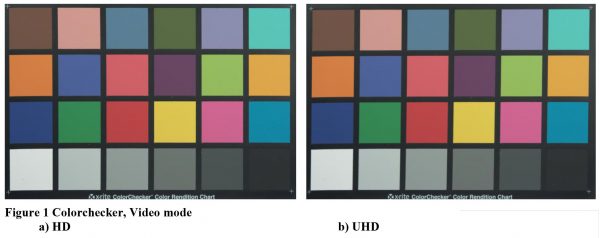
Alan puts it like this: “Skin tones are rather too pink, while all other colours with significant red content (orange, violet, salmon pink, purple, light orange, red and yellow) are all too bright and pink. The cyans are too bright.” Clearly this is a camera that colour-wise is better suited to using Film gamma at the very least, and ideally RAW for best results. Alan goes on, “Clearly, all pictures from this camera will need post-production grading to improve the colour performance.” He also notes that the camera responds to infra-red and “could benefit from having an infra-red stopping filter fitted.” This tallies with what some users have observed in the field.
Gamma curves and dynamic range:
In ProRes recording Alan determined that the camera has around 13 stops of dynamic range using Film gamma. The Video gamma setting is much more limited at around 10 stops.
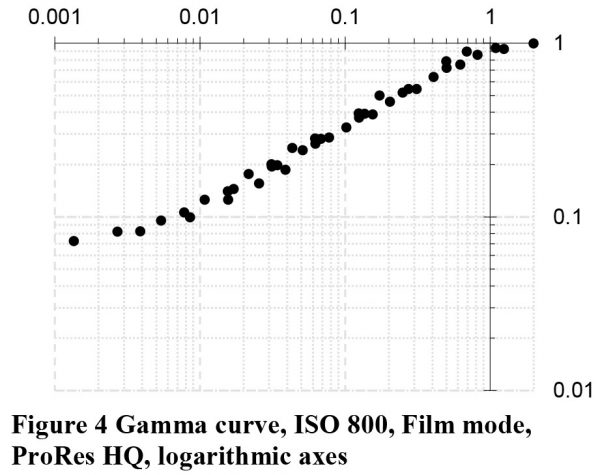
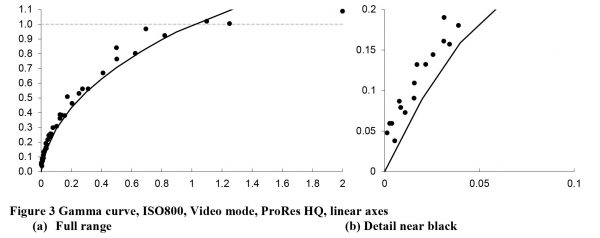
It’s a different story with RAW. The camera was measured at just over 14 stops of dynamic range in RAW 4:1. This is a good result, especially considering the price of the camera. To put this into perspective Alan measured the Canon C300 mkII at 15 stops of dynamic range. Both the URSA Mini 4.6 and C300 mkII are bettered by the ARRI Alexa and Amira, but then that comes as no surprise given their reputation and price. 14 stops of dynamic range is highly usable and far more flexible than many of us (non-high-end cinema shooters) are currently used to working with.
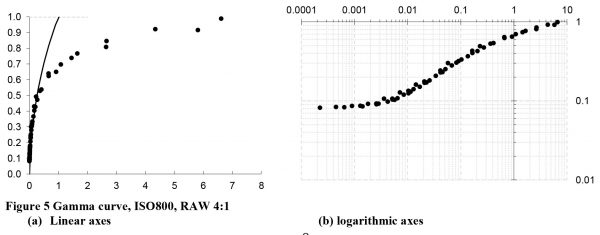
It’s worth noting that the Video gamma continued to cause Alan problems with analysis. He was unable to fully determine exactly whether the camera is attempting to record ITU Rec.601/709 or sRGB.
Aliasing:
HD: The camera can shoot HD in either a windowed (crop) or non-windowed (downscaled from full 35mm frame) mode. As expected, Alan notes that the “resolution is better if Windowing is switched off”.
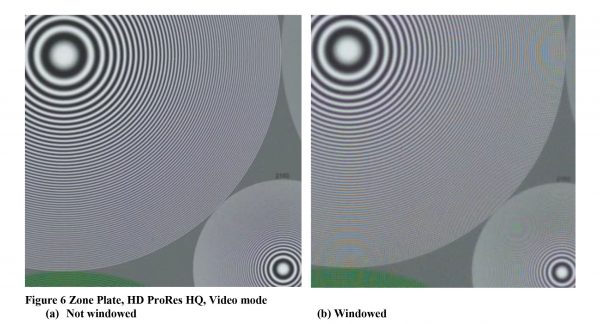
He also notes that “in non-Windowed mode the whole sensor is used via a scaling algorithm which works quite well”. Detail Sharpening can be applied to the image but should be left near default values as turning it up leads to some significant aliasing.
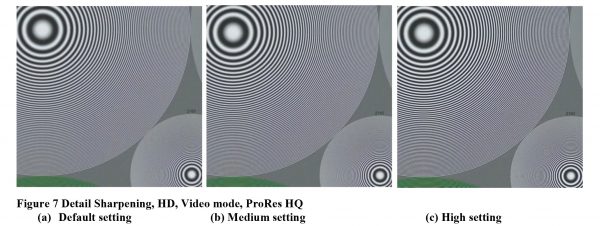
‘4k’ (UHD-1 3840×2160): As with the HD recording, Alan notes that when shooting in ProRes it is “no surprise that Detail Sharpening produces heavy aliasing. The Default setting is acceptable, but the higher settings should be avoided if at all possible.”
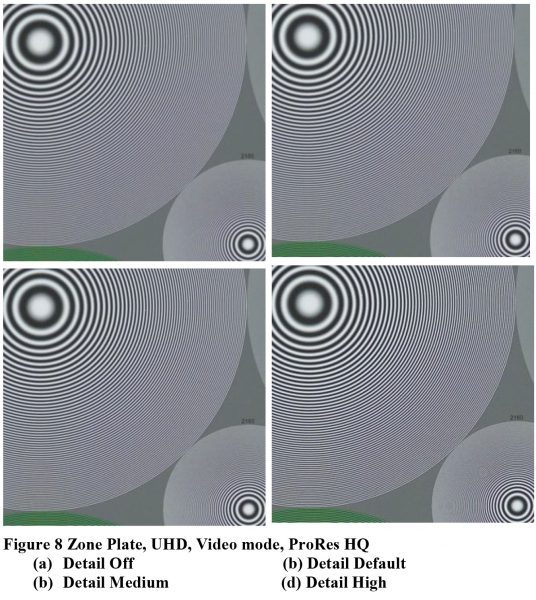
Moving to RAW and it seems that “Coloured aliasing is clearly visible”, which is oddly “not visible in ProRes recording, perhaps indicating that either the Bayer-pattern decoding is better in the camera, or that the ProRes coder has a spatial filter to remove it”.
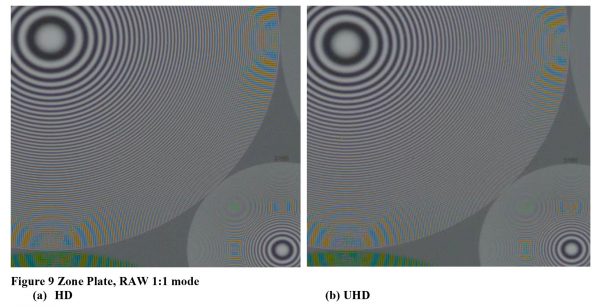
Noise:
As early adopters of the camera have already discovered, the URSA Mini 4.6K is not a low-light king. The native sensitivity of the sensor appears to be lower than many other modern cinema cameras.
To test the noise performance Alan’s tests are based on multiple exposures of the same X-rite ColourChecker chart. These measurements are then plotted and what you see below is PSNR (Peak Signal to Noise Ratio) with video level, at ISO800 with ProRes HQ recording. Because of its emphasis on how images are handled going through the broadcast chain, the EBU specification is primarily concerned with noise at mid-grey.
Starting with HD, in Video gamma the noise level at mid-grey (50%) is about -46dB, not reaching the figure EBU R.118 of -48dB for HD Tier 1, but exceeding the -44dB figure for HD Tier 2.
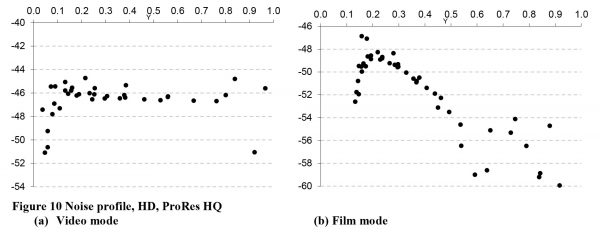
In Film gamma at mid-grey, the noise level of -54dB easily meets the R.118 criterion of -48dB, but the images need major post-production to make them acceptable.
Staying at ISO 800, but moving to UHD and RAW, things do not get better. Alan states that “the curve does not meet the R.118 criterion of -50dB at mid-grey for UHD, but just meets the -48dB for HD Tier 1. In this respect, RAW is more noisy than ProRes HQ, which is a surprise.” Again post-processing would appear to be required to try to bring the images back within the EBU spec.
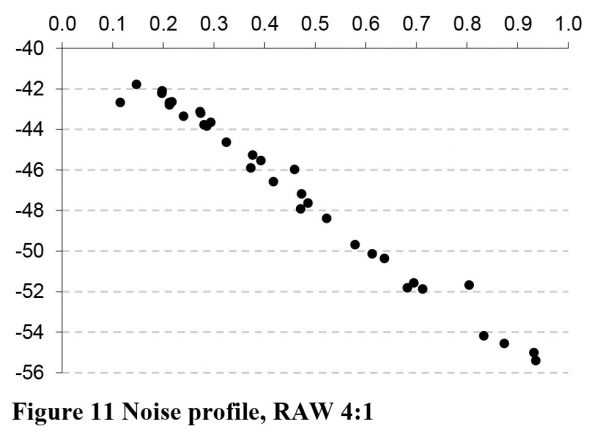
Alan then moves on look at performance at different ISO settings. Using ProRes it was found that “there is a noise floor at the lower ISO speeds, not permitting the noise levels to drop as expected. The rising slope at high ‘speeds’ also indicates that there is no noise-reduction in this camera.”
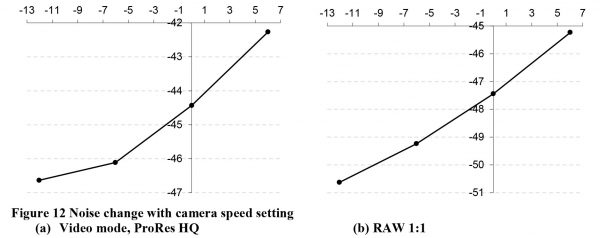
RAW recording can produce lower noise levels than ProRes HQ at lower ISO. Even so, Alan points out that “the post-processing needed to deal with the RAW mode will raise noise levels to levels similar to that of ProRes.” Because of this, to qualify for the stringent EBU R.118 tier 1 UHD categorisation, the camera should be used at ISO400.
Motion portrayal:
Alan tested the rolling shutter performance of the camera in his usual way, by shooting a rotating desk fan that can be speed-adjusted. His findings were that the camera had “fairly severe” distortion, but that this “is normal for a rolling-shutter camera”. This is unsurprising.
Report conclusions:
Below is an extract from Alan’s conclusions that sum up his findings:
“Resolution and aliasing at HDTV are quite good, although some high-frequency content pollutes the HD image as aliasing. At UHD, resolution falls a little short of the target, which is inevitable unless the sensor were to have significantly more photo-sites; coloured aliasing is visible both vertically and horizontally although the level is not particularly high.
“The colour performance is rather lurid, with a distinctly pink look to many colours, and the camera responds to infra-red. These conclusions may be related to each other. The performance is reminiscent of cameras having the colour matrix after the gamma correction, which is the wrong way round for best performance.
“The dynamic range is about 14 stops using RAW mode, less in ProRes HQ recording.”
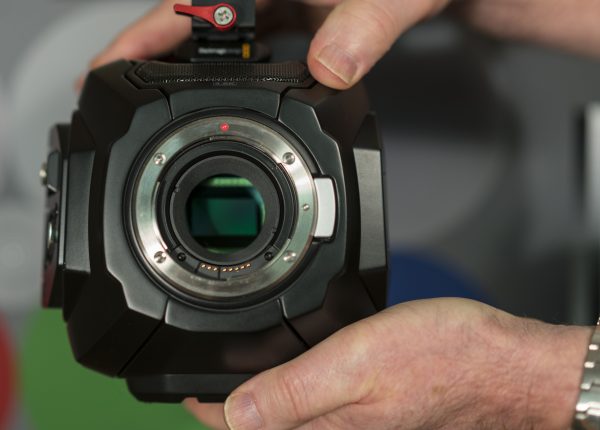
“Noise levels are consistently higher than is acceptable for EBU R.118 tiering at the highest level. In Video mode, it could qualify for HD Tier 2. Even so, the unusual colour performance requires considerable grading. In Film mode, the noise levels are lower, and at ISO settings up to 400 the camera could qualify for UHD Tier 2 or HD Tier 2L/2J, but the inevitable post-production grading to improve colour performance is likely to raise the noise to unacceptable levels. This implies that the camera is not really suited to broadcast use without careful grading and noise reduction.”
As we stated earlier, the Sony F65 is the only camera tested that currently qualifies for the top tier 1. The URSA 4.6K is a camera that could qualify for EBU UHD tier 2, but only at ISO settings up to 400. (As we’ve noted, other cameras that meet tier 2 include the ARRI Alexa, Amira and the Canon C300 mkII).
Shooting in HD, the camera could also qualify for EBU HD tier 2L/2J. This means that the image quality is sufficient for long-form TV and news programming.
As I mentioned earlier in the article, a much better 1920 x 1080 HD image can be obtained from the URSA Mini 4.6K by shooting 4K RAW and then downscaling in post – although whether this would be good enough to make the top HD Tier 1 wasn’t tested because this was a test of the camera and not of other software.
Another option that was not fully explored was the ability to shoot in the full 4.6K offered by the camera, and then downscaling it to UHD. The 4608×2592 photo-sites of the sensor create a non-standard image aspect that is slightly wider than DCI 4K. If the user is prepared to deal with the unconventional framing and then crop in post (or add black bands at the top and bottom of the image), then the resulting 4K image should be better than shooting natively in UHD.
My view:
The camera is clearly capable of some lovely images, as witnessed in many videos available online. Over 14 stops of dynamic range is lovely to have, but for best results it is clear that the user needs to use RAW. It gives the greatest amount of exposure latitude and room to correct and manipulate colours in post-processing. Luckily, Blackmagic Design include a free copy of the industry standard Davinci Resolve colour grading software in the box with the URSA. Of course, shooting RAW will also require a lot of storage and the processing power to deal with it.
When shooting RAW it is perhaps easiest to see the URSA 4.6K as a camera where only half of the image decisions are taken internally by the camera operator, the other half being done later in Resolve. This requires the user, or production, to invest greater time and energy into post processing. The ultimate reward will be 4K imagery that would otherwise be hard to attain from any other camera of the same cost.
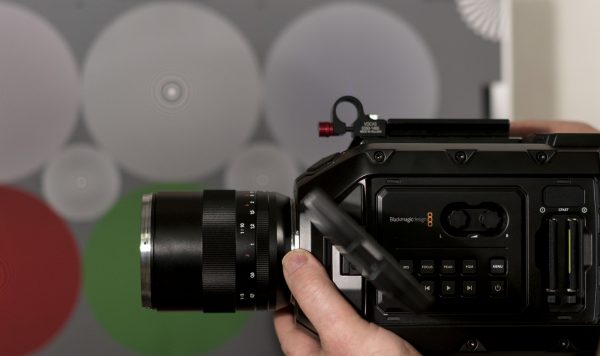
The Apple ProRes recording options are nice to have and resolution is good, but they have less dynamic range and it is not as easy to get the material to conform to known colour standards. These options are more for when the user needs to produce something quickly that has a pleasant look, rather than the most accurate.
The URSA Mini 4.6K is an interesting camera that brings RAW recording and a Super35 mm sensor at an affordable price. None of the Japanese makers, or RED, will give you RAW for the same price. It is not, however, a broadcast news camera replacement – there are other alternatives with built-in ND filters, better low light performance and video files that require less post production.
The URSA Mini 4.6K is for anyone who is prepared to spend time and effort post-processing their video. This camera really needs to be used in tandem with Davinci Resolve to get best results. If you light your shots, shoot RAW and process correctly, then I’m confident this camera currently offers the best image you can get for the money.
The full report that we commissioned will soon be available on the EBU website.



